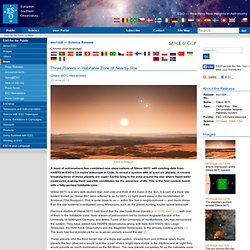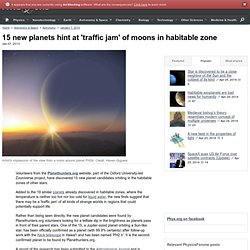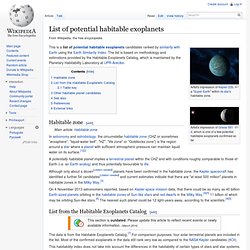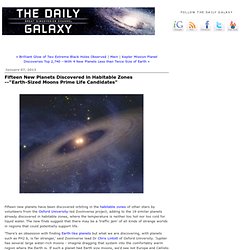

Every Red Dwarf Star Has a PlanetAnd There Are 200 Billion Such Stars in the Galaxy. Thanks to the now-defunctKepler telescope, last week NASA announced 715 new exoplanets in every Dr.

Seussian size and makeup imaginable, and nearly doubled the number of exoplanets known to humanity. And more keep on pouring in. With that horde of new worlds, you might have missed a smaller announcement by a group of astrophysicists at the University of Hertfordshire in the UK, who just tacked on eight more exoplanets right around the corner in our cosmic neighborhood. Three Planets in Habitable Zone of Nearby Star. Eso1328 — Science Release Gliese 667C reexamined 25 June 2013 A team of astronomers has combined new observations of Gliese 667C with existing data from HARPS at ESO’s 3.6-metre telescope in Chile, to reveal a system with at least six planets.

A record-breaking three of these planets are super-Earths lying in the zone around the star where liquid water could exist, making them possible candidates for the presence of life. Stars' Twinkle Reveals Potential for Habitable Worlds. In 1806, English poet Jane Taylor famously lamented that a little star’s twinkle, twinkle left her wondering what it was.

Fast-forward 207 years and a new analysis of starlight collected by NASA’s Kepler space telescope shows patterns in the flicker that are directly tied to the amount of boiling taking place on a star’s surface, a key indicator of its size, mass and evolutionary state. VIDEO: 'Singing Stars' Reveal Star System Secrets That information, in turn, reveals volumes about any orbiting planets, including those fortuitously positioned from their parent stars for liquid surface water -- apparently a key ingredient for life. “Everything you know about planets is tied to what you know about the host star,” Fabienne Bastien, an astronomy graduate student at Vanderbilt University, told Discovery News.
“We don’t observe the planets directly. Closest Earth-like planet may be 13 light years away - space - 06 February 2013. Let's take a peek at the neighbours.

The closest Earth-like planet is probably orbiting a dim red star just 13 light years away. While that's too far for a visit, future telescopes might be able to see it and probe for signs of life. Astronomers: Earth-size planets in habitable zones are more common than previously thought. The 'habitable edge' of exomoons. Astronomers have their fingers crossed that within the haul of data collected by NASA's Kepler mission, which has already detected nearly three thousand possible exoplanets, hide the signatures of the very first exomoons.

The discovery of alien moons will open up an exciting new frontier in the continuing hunt for habitable worlds outside the Solar System. With the confirmation of exomoons likely right around the corner, researchers have begun addressing the unique and un-Earthly factors that might affect their habitability. Because exomoons orbit a larger planetary body, they have an additional set of constraints on their potential livability than planets themselves.
Examples include eclipses by their host planet, as well as reflected sunlight and heat emissions. 15 new planets hint at 'traffic jam' of moons in habitable zone. Volunteers from the Planethunters.org website, part of the Oxford University-led Zooniverse project, have discovered 15 new planet candidates orbiting in the habitable zones of other stars.

List of potential habitable exoplanets. Artist's impression of Gliese 581 d, which is one of a few potential habitable exoplanets confirmed so far This is a list of potential habitable exoplanets candidates ranked by similarity with Earth using the Earth Similarity Index.

The list is based on methodology and estimations provided by the Habitable Exoplanets Catalog, which is maintained by the Planetary Habitability Laboratory at UPR-Arecibo. Gliese 581 g Tops List of 5 Potentially Habitable Exoplanets. The controversial exoplanet Gliese 581g is the best candidate to host life beyond our own solar system, according to a new ranking of potentially habitable alien worlds.

Gliese 581g shot to the top of the list — which was published Thursday (July 19) by researchers at the University of Puerto Rico at Arecibo’s Planetary Habitability Laboratory (PHL) — after a new study marshaled support for its long-debated existence. The exoplanet was discovered in September 2010, but other astronomers began casting doubt on its existence just weeks later. Now Gliese 581g's discoverers have rebutted their critics' charges in a new paper, and have done so effectively enough to get the PHL onboard. 'Habitable' planet discovered circling Tau Ceti star. A planet with conditions that could support life orbits a twin neighbour of the sun visible to the naked eye, scientists have revealed.

The world is one of five thought to be circling Tau Ceti, a star just 12 light years away that is almost identical to the sun. Astronomers estimate the Tau Ceti planets to be two to six times bigger than Earth. One of them, with five times the Earth's mass, lies in the star's "habitable zone". Fifteen New Planets Discovered in Habitable Zones. 'There's an obsession with finding Earth-like planets but what we are discovering, with planets such as PH2 b, is far stranger,' said Zooniverse lead Dr Chris Lintott of Oxford University. 'Jupiter has several large water-rich moons - imagine dragging that system into the comfortably warm region where the Earth is.

"My God, it's full of planets! They should have sent a poet." NASA Kepler hints at over 250 new potentially habitable worlds NASA Kepler released last month 18,406 planet-like detection events from its last three year mission to search for exoplanets (Kepler Q1-Q12 TCE). Further analysis is required by the NASA Kepler Team and the scientific community to extract and identify true planets, including those potentially habitable. The Planetary Habitability Laboratory @ UPR Arecibo (PHL) performed a preliminary analysis and identified 262 candidates for potentially habitable worlds in this dataset. These candidates become top priority for further analysis, additional observations, and confirmation. Search for life suggests solar systems more habitable than ours. Public release date: 3-Dec-2012 [ Print | E-mail Share ] [ Close Window ] Contact: Pam Frost GorderGorder.1@osu.edu 614-292-9475Ohio State University SAN FRANCISCO—Scattered around the Milky Way are stars that resemble our own sun—but a new study is finding that any planets orbiting those stars may very well be hotter and more dynamic than Earth.
If not for clouds and nitrogen, Earth could be an uninhabitable hell right now. With the explosion of exoplanet discoveries, researchers have begun to seriously revisit what it takes to make a planet habitable, defined as being able to support liquid water. At a basic level, the amount of light a planet receives sets its temperature. But real worlds aren't actually basic—they have atmospheres, reflect some of that light back into space, and experience various feedbacks that affect the temperature. Attempts to incorporate all those complexities into models of other planets have produced some unexpected results.
Some even suggest that Earth teeters on the edge of experiencing a runaway greenhouse, one that would see its oceans boil off. Warm Water Worlds May Have Been Found According to New Study by German Scientists. 60 Flares Reddit 50 Facebook 8 Twitter 0 Google+ 0 Pin It Share 1 1 Email -- Email to a friend 60 Flares × A new study by German scientists has concluded that the recently discovered planets Kepler-62e and Kepler-62f are the first viable candidates for habitable zone water planet. One of the main ingredients in the formation of life is the abundance of water. Kepler-62e and Kepler-62f are well within the habitable zone and according to their research water planets in the habitable zone are expected to have distinct geophysics and geochemistry of their surfaces and atmospheres which should be viewable soon.
With a new generation of telescopes coming online, such as the James Web Space Telescope it will be possible to determine if the Kepler worlds are in fact water worlds. The JWST will be observing in the infrared, it’s a key technique for achieving this, because it better penetrates obscuring dust and gas, allows observation of dim cooler objects, and because of cosmological redshift.